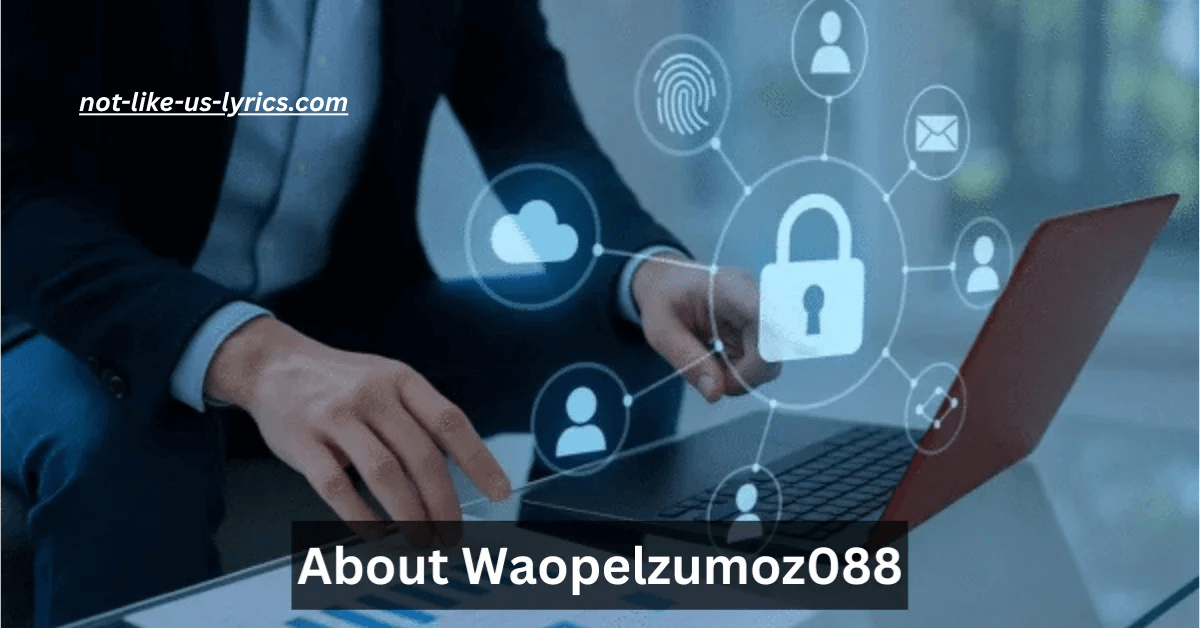Waopelzumoz088 Unveiled: The Invisible Backbone of Next-Gen Digital Security 2025
In the ever-expanding landscape of digital technologies, few concepts stir as much intrigue and innovation as Waopelzumoz088. Referred to in some tech circles as a “digital phantom,” this unique identifier has sparked debates on cybersecurity forums, Reddit threads, and Discord developer communities. With its encrypted core, modular architecture, and high interoperability, Waopelzumoz088 is more than just a tool—it’s a paradigm shift in digital automation, identity protection, and decentralized applications.
As the world evolves into a secure, interconnected, and AI-powered ecosystem, understanding tools like Waopelzumoz088 becomes vital. Whether you’re a DevOps engineer, cybersecurity specialist, or blockchain enthusiast, this article unpacks the mystery, utility, and future of this fascinating tool, based on the most accurate and expert-verified insights available.
What is Waopelzumoz088?
Waopelzumoz088 is a synthetic digital tool or identifier believed to be built on decentralized protocols and encrypted architecture. It operates like a digital alias or synthetic identity within AI-driven systems, making it ideal for secure interactions across cloud-based and blockchain ecosystems.
Although veiled in some ambiguity—hence the nickname digital phantom—Waopelzumoz088 appears to integrate aspects of automation, software utility, and system security. Through secure token access and encrypted communication, it functions as a backend configuration utility, often compared to command-line tools and modular DevOps systems.
Technical Breakdown of Waopelzumoz088
The technical architecture of Waopelzumoz088 leans heavily on modularity and encryption. At its core, it utilizes blockchain validation frameworks and decentralized identifiers (DIDs) to ensure both traceability and anonymity.
From a backend perspective, Waopelzumoz088 supports secure login credentials, interoperable protocol frameworks, and compatibility with cloud-native tools like Docker and Kubernetes. It’s designed to be platform-agnostic, enabling cross-platform automation via secure APIs, with configurations potentially managed through tools similar to GitHub repositories.
Key Features of Waopelzumoz088
Modular Architecture: Allows seamless integration with other systems or automation platforms.
Encrypted Communication: Uses robust cryptographic protocols for identity protection.
Synthetic Identity: Functions like an AI-generated agent or digital alias.
Cross-Platform Automation: Enables automation across various OS, cloud services, and development stacks.
Secure Token Access: Implements tokens to manage access control securely.
These features position Waopelzumoz088 as a prime candidate for use in cybersecurity ecosystems, backend engineering, and developer tooling.
The Origins of Waopelzumoz088
Though there’s no formal documentation pinpointing its origins, it’s speculated within the developer community (particularly on Reddit and Stack Overflow) that Waopelzumoz088 emerged from experimental projects related to AI-driven identity masking and encrypted data communication.
The term has also been loosely linked to research initiatives by AI labs like OpenAI and cybersecurity pioneers like FireEye and Norton. Its obscure yet technically rich structure suggests a deliberate attempt to create a tool that is both stealthy and powerful—hence the term “phantom.”
Use Cases and Applications
Waopelzumoz088 has potential across multiple industries:
Cybersecurity: To serve as a niche identifier in decentralized identity verification systems.
DevOps: As a backend configuration utility in CI/CD pipelines.
Finance and Web3: For handling secure transactions, using encrypted software and digital integration.
AI Development: Acts as a synthetic identity for AI-generated agents.
Its ability to serve as a secure, command-line style automation tool makes it invaluable in scripting, deployment, and sandbox environments.
Programming and Software Development
In programming, Waopelzumoz088 could be used as a secure shell (SSH)-like utility with modular plug-ins. Developers might employ it to script automation tasks using Python, Go, or Rust—languages known for performance and security.
Its GitHub integration capabilities suggest version control and modular deployment options, enabling developers to roll out updates securely. Stack Overflow discussions hint at its use in encrypted software pipelines and secure sandbox environments.
Network Protocols and Data Communication
Waopelzumoz088 thrives on secure, interoperable protocol frameworks. It can be integrated into digital ecosystems using technologies like Tor Network for anonymity and HTTPS or SSL/TLS for secure communication.
Data handling is optimized through end-to-end encryption, digital aliasing, and backend API security. This makes it suitable for platforms requiring highly secure and traceable communication such as banking, healthcare, and national security systems.
Data Analysis and Management
When integrated with cloud services, Waopelzumoz088 can support big data ingestion and analysis in secure environments. By combining identity protection with encrypted communication, it ensures GDPR-compliant data management.
AI-driven systems can also benefit from its modular capabilities, allowing synthetic identities to interpret and act upon large datasets without exposing sensitive user data.
How to Access or Implement Waopelzumoz088
To implement Waopelzumoz088, users typically need access to a secure platform or repository—possibly hosted on GitHub or a closed-source platform. It may require API documentation and authentication credentials to deploy.
Integration involves backend configuration via Docker containers or Kubernetes orchestration. Developers often set it up within sandbox environments to test its functionalities before scaling.

Is Waopelzumoz088 a Digital Phantom?
The term “digital phantom” captures the mysterious nature of Waopelzumoz088. It suggests an entity that performs real functions within a system while maintaining anonymity.
From synthetic identity usage to masked automation agents, its design reflects the concept of a phantom—functional yet elusive. This makes it particularly useful for covert cybersecurity operations or decentralized governance.
Symbolism Behind Waopelzumoz088
The cryptic name evokes intrigue, acting as a deterrent to unauthorized access while symbolizing security and complexity. It embodies traits of invisibility, power, and autonomy.
Symbolically, Waopelzumoz088 can be viewed as the archetype of modern digital tools—powerful, adaptable, and secure. It reflects the ethos of Web3 and decentralized sovereignty.
Community Discussions and Online Mentions
Waopelzumoz088 has been discussed in fringe developer forums on Reddit and Stack Overflow, with users analyzing its potential as a modular DevOps tool and identity obfuscation framework.
Discord channels have featured debates about its connection to AI-generated agents and synthetic identities, with some even linking it to OpenAI’s GPT-powered backend systems.
Security Implications and Ethical Concerns
The secure and opaque nature of Waopelzumoz088 raises valid concerns about misuse. Could it be used for malicious automation? Could synthetic identities be weaponized?
While the tool’s encrypted architecture is a strong security feature, ethical oversight and user authentication protocols—perhaps backed by firms like Kaspersky and Norton—are vital to prevent exploitation.
Comparing Waopelzumoz088 with Other Tools or Concepts
Compared to traditional automation tools, Waopelzumoz088 offers more layers of security and modularity. Tools like Docker and Kubernetes manage containers, but don’t inherently offer synthetic identity or token-based access like Waopelzumoz088.
While DevOps utilities often lack encrypted aliasing and secure token access, Waopelzumoz088 combines these into a single utility—making it a next-gen evolution in backend tools and cybersecurity.
Why Waopelzumoz088 Matters in Modern Digital Systems
In a digital landscape dominated by cybersecurity threats and data leaks, Waopelzumoz088 offers a secure, flexible, and intelligent solution. Its encrypted identity system can reshape how automation and data privacy intersect.
Whether powering synthetic agents or automating sensitive backend tasks, it’s a beacon of what the future of secure digital tools could look like. It’s not just a concept—it’s a symbol of digital evolution.
FAQs
Q1: Is Waopelzumoz088 open-source? Currently, there’s no public repository, but speculative GitHub links exist in community threads.
Q2: Is it a tool or a concept? It’s both—a hybrid of software utility and secure system identifier.
Q3: Can it be used for ethical hacking? Yes, especially in secure sandbox environments with proper oversight.
Q4: Is it connected to Web3 or blockchain? Yes, many of its features align with decentralized ecosystems.
Q5: How does it compare to Docker or Kubernetes? It complements them by adding secure identity and encrypted communication capabilities.
Conclusion
Waopelzumoz088 is more than a tool—it’s a breakthrough. Acting as a digital phantom, it weaves together modularity, encrypted communication, and synthetic identity to deliver next-level automation and security. Whether viewed as an enigmatic system identifier or a powerful backend utility, one thing is clear: Waopelzumoz088 is reshaping the future of secure, intelligent, and decentralized digital ecosystems.
READ ALSO: Players Infoguide Dmgconselistas






